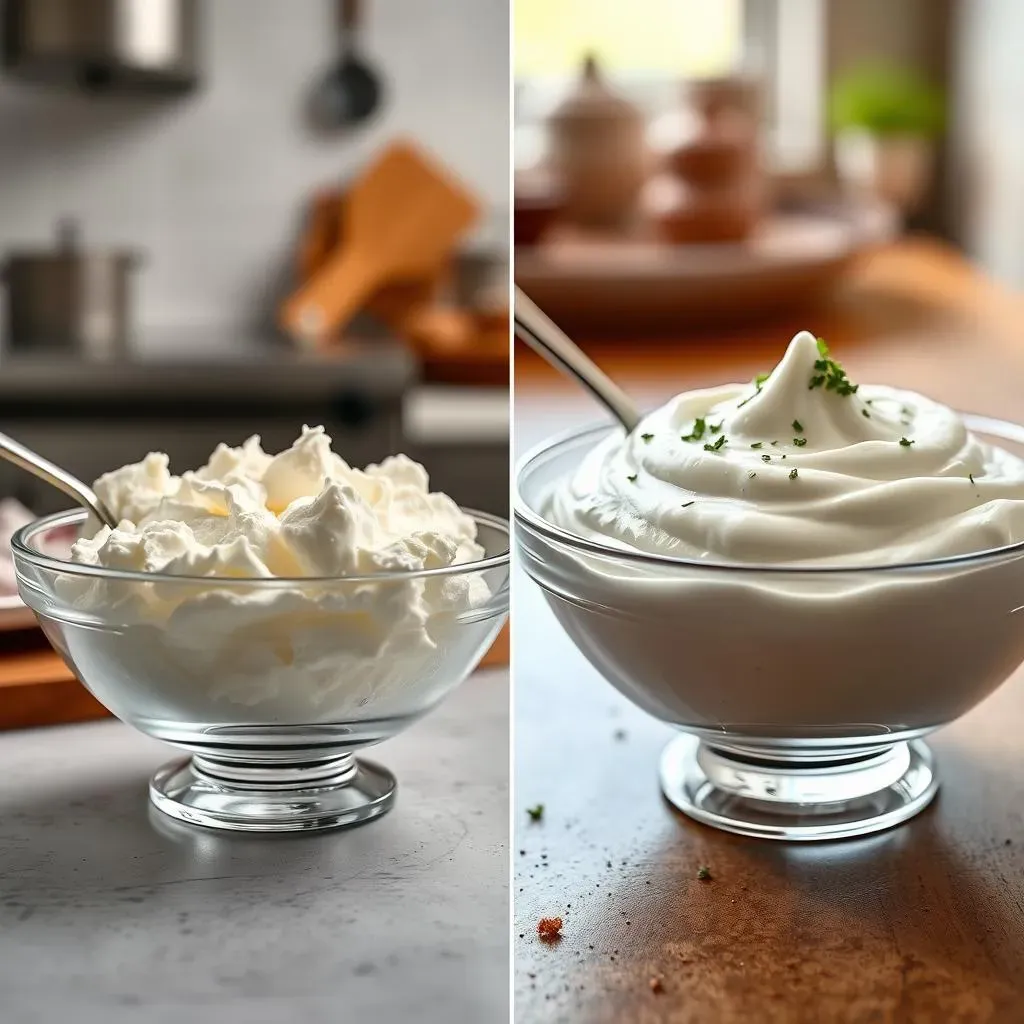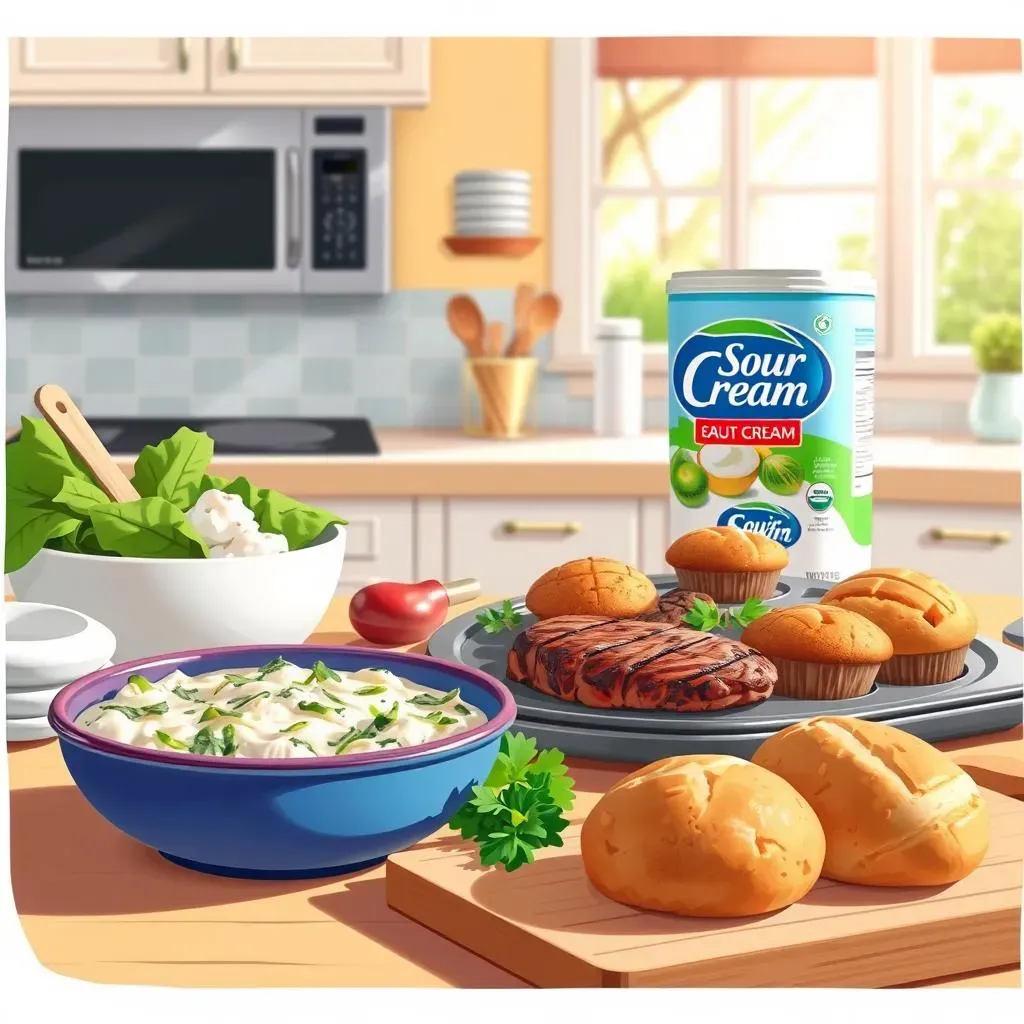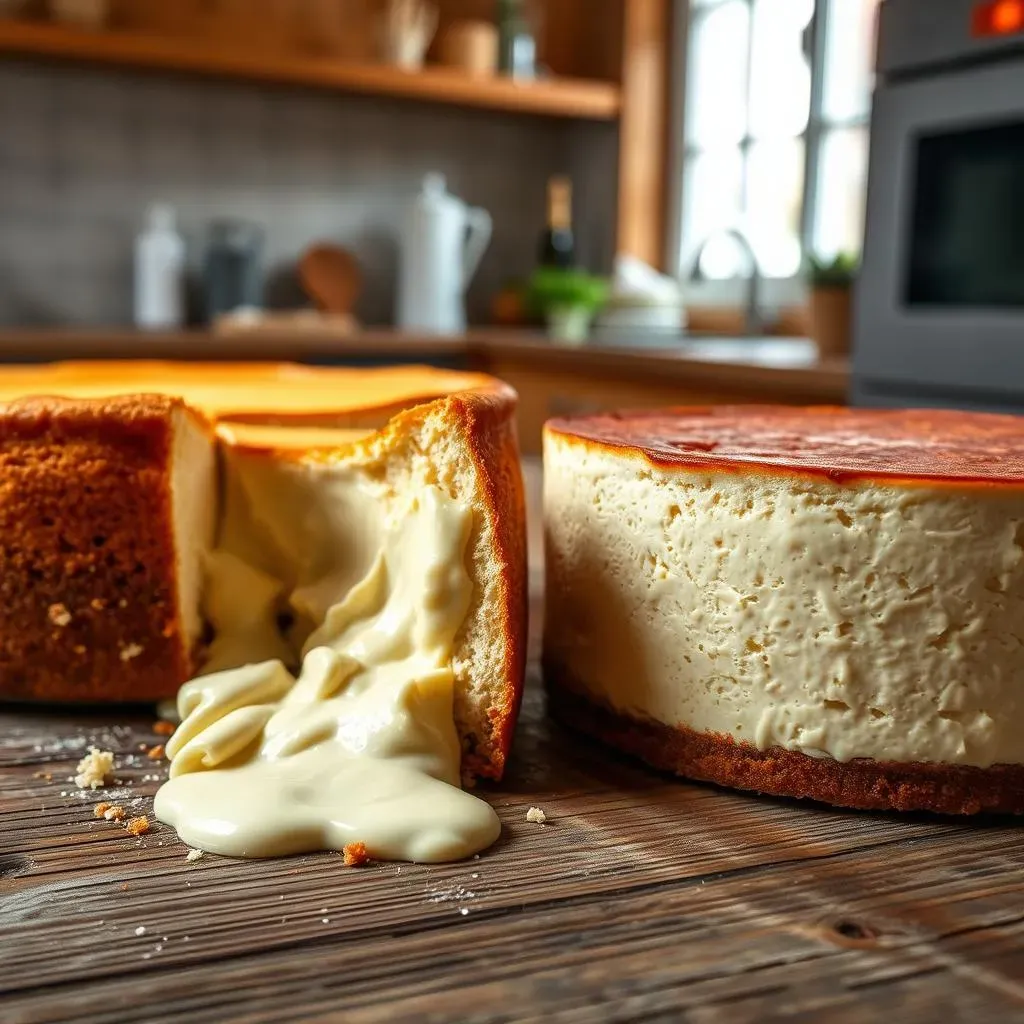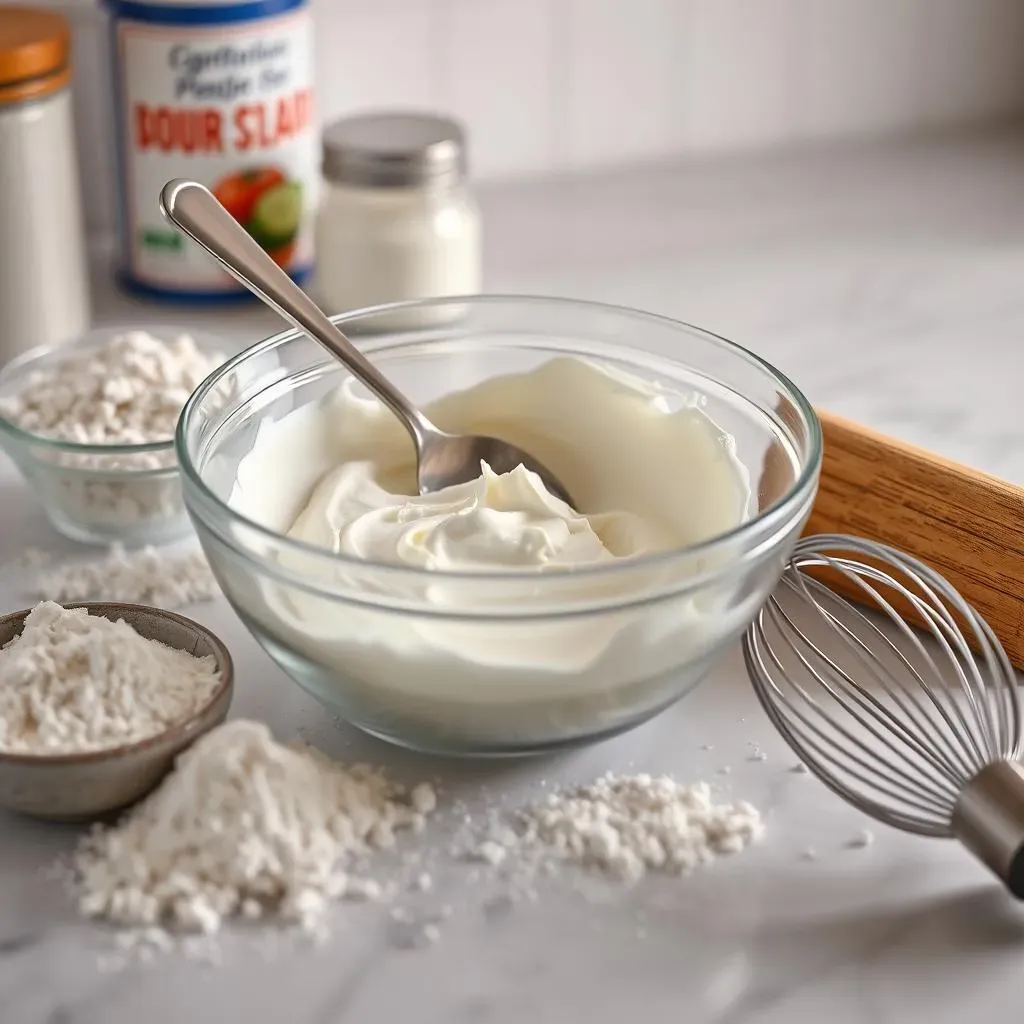Table of Contents
Ever stared blankly at a recipe, realizing you're missing a key ingredient – cream cheese? And all you have is sour cream? Don't despair! This article tackles the burning question: can sour cream substitute for cream cheese? We'll explore the similarities and crucial differences between these two dairy delights, guiding you through scenarios where a swap works like a charm and situations where it might lead to culinary chaos. We'll delve into the specific recipes and applications where sour cream shines as a cream cheese substitute, and equally important, highlight situations where it falls short. Learning when and how to use sour cream in place of cream cheese will save you trips to the store and empower you to experiment confidently in the kitchen. Prepare to unlock a world of culinary possibilities as we unravel the mysteries behind this common cooking conundrum. Get ready to become a sour cream substitution expert! Let's find out if you really *can* use sour cream instead of cream cheese.
Understanding Sour Cream and Cream Cheese: Key Differences

Understanding Sour Cream and Cream Cheese: Key Differences
Fat Content and Texture
Let's start with the most obvious difference: fat content. Cream cheese boasts a significantly higher fat percentage than sour cream. This translates directly to texture. Cream cheese is thick, rich, and almost spreadable straight from the fridge. Think of that luscious creaminess you get in cheesecake. Sour cream, on the other hand, has a thinner, tangier consistency. It's more of a pourable liquid, ideal for adding a zing to soups or dips. This difference in fat content is a big factor when considering substitution; a recipe calling for the richness of cream cheese might not get the same result with sour cream's lighter texture.
Think of it like this: cream cheese is like a fluffy cloud, while sour cream is more like a refreshing drizzle. You wouldn't use a drizzle to make a cloud, right? The same principle applies to baking and cooking.
Acidity and Flavor Profile
Next up, let's chat about flavor. Both sour cream and cream cheese possess a tangy edge, but their flavor profiles differ subtly. Sour cream’s tang is much more pronounced, a sharp bite that cuts through richness. Cream cheese has a milder, more creamy tang. This subtle difference in tanginess can significantly affect the overall taste of a dish. For instance, if a recipe relies on cream cheese's subtle tang for balance, using sour cream might make it too acidic. Conversely, a recipe that needs a sharper flavor might benefit from sour cream's higher acidity.
Want to learn more about substituting other dairy products? Check out our guide on substituting Greek yogurt for sour cream. It's a great resource for expanding your culinary knowledge!
Ingredient | Fat Content (approx.) | Acidity | Texture |
|---|---|---|---|
Cream Cheese | 33% | Mild | Thick, spreadable |
Sour Cream | 18-20% | High | Thin, pourable |
Cooking and Baking Behaviors
Finally, let's talk about how each behaves under heat. Cream cheese melts smoothly and evenly, lending a creamy texture to sauces and baked goods. Sour cream, on the other hand, can curdle if exposed to high heat. This is because of the differing protein structures in each dairy product. So, while you can use sour cream in some baked goods, you need to be careful about the temperature and how it’s incorporated into the recipe. Cream cheese is much more forgiving in this regard. If you're baking a cheesecake, for example, using sour cream instead of cream cheese would be a recipe for disaster (unless you're aiming for a very different texture). It's all about understanding the unique properties of each ingredient.
Need more ideas for sour cream substitutions? Our guide on using sour cream instead of buttermilk might be helpful!
- Cream cheese melts smoothly.
- Sour cream can curdle under high heat.
- Consider heat sensitivity when substituting.
When Sour Cream Works as a Cream Cheese Substitute: Recipes and Applications

When Sour Cream Works as a Cream Cheese Substitute: Recipes and Applications
Surprisingly, sour cream can be a surprisingly effective cream cheese stand-in in certain situations! Its tangier flavor and thinner consistency actually work to its advantage in some recipes. Think creamy dips and sauces where the extra tang adds a delightful zing. For example, in a spinach artichoke dip, sour cream can actually enhance the overall flavor profile, providing a brighter, more vibrant taste than cream cheese alone. The slightly thinner consistency blends well, creating a smooth, delicious dip. Just remember to adjust the seasoning accordingly, as the increased acidity might require a touch less lemon juice or vinegar.
Looking for more ways to use sour cream? Check out our article on substituting sour cream for cream cheese in frosting for some sweet inspiration!
- Dips and Spreads: Sour cream's tang adds a zesty twist.
- Sauces: It can create a lighter, brighter sauce.
- Marinades: The acidity tenderizes meat beautifully.
Another unexpected win for sour cream? Marinades! Its high acidity helps to tenderize tougher cuts of meat, creating a more flavorful and juicy end result. While cream cheese wouldn't provide the same tenderizing effect, sour cream's tang complements many herbs and spices, creating a more complex marinade. Think of it as a secret weapon for grilling tougher cuts of steak or chicken. Just remember to let the meat marinate for a longer period, as sour cream might require a bit more time to penetrate the meat fibers.
Want to explore other dairy swaps? Our guide on using sour cream instead of mayonnaise offers more great ideas!
Recipe Type | Sour Cream Advantage | Considerations |
|---|---|---|
Dips & Spreads | Adds zesty tang | Adjust seasoning for increased acidity |
Marinades | Tenderizes meat | Marinate longer for better penetration |
While not ideal for baking where a creamy, smooth texture is paramount, sour cream can sneak into certain baked goods, adding moisture and a subtle tang. In some quick breads, like banana bread, a small amount of sour cream can replace a portion of the cream cheese, adding a delightful twist to the flavor. It's all about balance! Too much sour cream might make the bread overly acidic, but a small amount adds moisture and a unique tang that elevates the overall taste. It's a subtle change, but a welcome one for those who enjoy a more complex flavor profile in their baked goods.
For more baking substitutions, check out our article on substituting sour cream for Greek yogurt in baking.
- Quick Breads: Adds moisture and subtle tang.
- Muffins: Enhances flavor and texture (in moderation).
- Cakes: Use sparingly; may affect texture.
When Sour Cream Fails as a Cream Cheese Substitute: Limitations and Alternatives

When Sour Cream Fails as a Cream Cheese Substitute: Limitations and Alternatives
Baking Blunders: Why Sour Cream Isn't Always the Answer
Let's be clear: sour cream is a fantastic ingredient, but it's not a magic bullet for every recipe. When a recipe calls for cream cheese, it's usually because of its unique properties – its rich, creamy texture and its ability to hold its shape when baked. Sour cream's thinner consistency and tendency to curdle under high heat make it a poor substitute in most baked goods. Think cheesecakes, frostings, or even cream cheese-based fillings. Using sour cream in these applications would drastically alter the texture and possibly even the taste, resulting in a less-than-desirable outcome. For example, imagine trying to make a cheesecake with sour cream – the result would likely be a runny, curdled mess, far from the creamy perfection you're aiming for.
Need a cream cheese substitute for baking? Check out our guide on using cream cheese instead of sour cream for some excellent alternatives!
- Cheesecakes: Sour cream will curdle and create a runny texture.
- Frostings: The thinner consistency won't hold its shape.
- Fillings: Similar texture issues will arise.
Recipes Demanding Cream Cheese's Unique Qualities
Certain recipes rely heavily on cream cheese's specific qualities beyond just its creamy texture. Some recipes use cream cheese as a base for sauces or as a binding agent. In these cases, sour cream's higher acidity and thinner consistency could completely throw off the recipe's balance. For instance, some pasta sauces use cream cheese to create a smooth, creamy consistency and a delicate flavor. Substituting sour cream would result in a sauce that's too tangy and thin, lacking the desired richness and creaminess. Similarly, in some savory dishes, cream cheese acts as a binding agent, helping to hold ingredients together. Sour cream's inability to perform this function would lead to a less cohesive and potentially messy dish.
For more information on substituting other ingredients, check out our article on substituting sour cream for cream cheese for more detailed information.
Recipe Type | Why Sour Cream Fails | Better Alternatives |
|---|---|---|
Cream-based sauces | Too thin and tangy | Ricotta, mascarpone |
Binding agent | Doesn't bind well | Cream cheese, mashed potatoes |
Exploring Better Alternatives: Cream Cheese Substitutes
So, if sour cream isn't the answer, what is? Fortunately, several excellent alternatives to cream cheese exist, each with its own unique properties. For baking, alternatives like ricotta cheese (for a slightly tangier result) or mascarpone cheese (for a richer, sweeter flavor) often work well. These cheeses provide a similar creamy texture without the curdling risk associated with sour cream. For savory applications, alternatives like Greek yogurt (with some added lemon juice to enhance tang) or even silken tofu (for a vegan option) can provide a creamy base without the sharp acidity of sour cream. The key is to choose an alternative that complements the flavor profile and desired texture of the specific recipe.
If you're curious about other dairy substitutions, be sure to check out our complete guide on substituting sour cream for crème fraîche!
- Ricotta cheese: Adds a tangy twist.
- Mascarpone cheese: Offers richness and sweetness.
- Greek yogurt: Provides creaminess with added tang (lemon juice).
- Silken tofu: A vegan alternative for creaminess.
Tips and Tricks for Successful Substitution: Achieving the Right Texture and Flavor

Tips and Tricks for Successful Substitution: Achieving the Right Texture and Flavor
Adjusting for Texture: Thinning and Thickening
One of the biggest hurdles when substituting sour cream for cream cheese is the difference in texture. Sour cream is much thinner. To compensate, you might need to thicken it up. A simple way to do this is by adding a thickening agent like cornstarch or flour. Mix a small amount of cornstarch or flour with a little cold water to create a slurry, then whisk it into the sour cream. Heat gently while stirring constantly to avoid lumps. This will create a creamier consistency closer to that of cream cheese. Alternatively, if you’re aiming for a thinner spread or sauce, you can thin out cream cheese by adding a splash of milk or cream. The key is to find the right balance for your specific recipe.
For more information on sour cream substitutes, check out our article on using cream cheese instead of sour cream for more ideas!
- Cornstarch or flour: Thicken sour cream for creamier consistency.
- Milk or cream: Thin cream cheese for a pourable consistency.
- Experiment to achieve desired texture.
Balancing the Tang: Controlling Acidity
Sour cream's higher acidity is another factor to consider. If your recipe calls for the milder tang of cream cheese, you'll want to reduce the sour cream's acidity. One simple trick is to add a pinch of baking soda to neutralize some of the sourness. Start with a small amount and taste as you go, adding more baking soda until you achieve the desired level of tang. Alternatively, you can balance the sour cream's acidity by adding a touch of sweetness. A teaspoon or two of sugar or honey can help mellow out the tang, creating a more balanced flavor. Remember, it's all about finding that perfect equilibrium.
If you are interested in other dairy substitutions, you might find our guide on sour cream as a crème fraîche substitute helpful.
Method | Description | Effect |
|---|---|---|
Baking Soda | Neutralizes acidity | Reduces sourness |
Sugar/Honey | Adds sweetness | Balances tang |
Temperature Control: Avoiding Curdling
As we discussed earlier, sour cream can curdle under high heat. To prevent this, incorporate sour cream into recipes gradually and at lower temperatures. If you're using sour cream in a hot sauce, add it towards the end of the cooking process, after the heat has been turned down. Stir gently to incorporate it evenly without causing it to separate. In baked goods, gently fold the sour cream into the batter rather than vigorously mixing it. This helps maintain the creaminess and prevents curdling. Remember, patience is key when working with sour cream in place of cream cheese!
Looking for more ways to use sour cream? Check out our post on using sour cream instead of mayonnaise!
- Add sour cream gradually to hot dishes.
- Reduce heat when incorporating sour cream.
- Gently fold sour cream into batters.